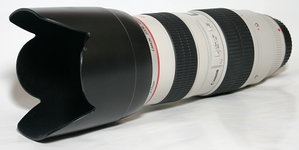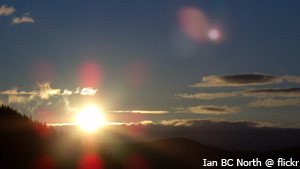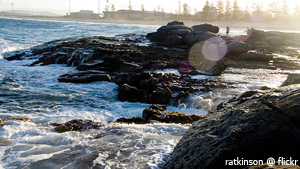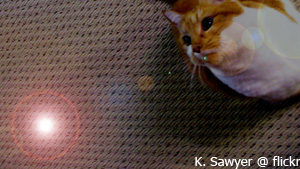
I get a lot of people sending me images with ‘mysterious’ problems, and I figured it was only fair if I run a series of articles about how you can alleviate these problems. The most frequent problem is actually a lens-flare related problem, and there seems to be some confusion as to what lens flare actually is.
I suppose the first thing we should discuss is just what lens flare actually is. Most commonly seen in photographs, lens flare can appear as bright circles, smears of light or glimmering lines.
On some occasions, it can even appear as a thin film over the entire picture that makes the image itself lighter.

Why does this phenomenon occur? Lens flare is normally seen because the photographer took the picture into the general direction of the sun. The basic idea is this – some sunlight gets into the camera lens at just the right angle that it bounces around the interior of the camera until some of it ends up on the film.
If that’s the case, then how can you test your camera to see how it deals with the lens flare issue? First and foremost, there is the obvious way of aiming it right at the sun and taking a picture. This is the most common way to get your lens to produce lens flare, but not the only way. In fact, some lenses have no problem taking photos towards the sun, but fail miserably in other tests.
 A second way to test for lens flare is what is known as the ‘window test’. Aim the camera someplace indoors, but have a bright window just out of the view of the lens. If your image, upon developing ended up with the tell tale signs of lens flare, you know your camera can’t handle that sort of situation so well.
A second way to test for lens flare is what is known as the ‘window test’. Aim the camera someplace indoors, but have a bright window just out of the view of the lens. If your image, upon developing ended up with the tell tale signs of lens flare, you know your camera can’t handle that sort of situation so well.
Another way that you can test your lens is the ‘bird in a tree’ approach. For this, aim your camera at a bird (or something of similar size and detail) against a bright sunny sky, but without aiming directly at the sun. Check for contrast loss at the edges of the bird or object. Generally, what you will see is the light ‘swallows’ up the outer edges of the bird. The more of the bird that is ‘swallowed’ up, the more lens flare is occurring in this case.
These aren’t the only ways to come up with lens flare. In fact, you don’t even need to have lens flare show up in your original photo to have it appear later. But why is this? Well, Photoshop has come up with its own ‘lens flare effect’ that you can apply to your images long after you’ve originally taken them. It offers a wide range of options to choose between to get you the look you are after.
 Okay, so I thought we were trying to avoid lens flare. Why would Photoshop come up with something people try to avoid? For the simple fact that lens flare shouldn’t always be avoided. In fact, it can a little something extra to your images when used in the right circumstances.
Okay, so I thought we were trying to avoid lens flare. Why would Photoshop come up with something people try to avoid? For the simple fact that lens flare shouldn’t always be avoided. In fact, it can a little something extra to your images when used in the right circumstances.
Thing is, well, there are very rarely ‘right circumstances’ for lens flare: There’s an excellent reason for why photographers have been trying to avoid them for dozens of years, and it’s a bit daft to try and use software to put ‘em back in…
Is there an easy way to avoid lens flare?
Why yes, there’s a very easy way: Keep your lens-cap on your camera when you’re taking photos!
Okay, so maybe that’s not the most convenient piece of advice. It does have a kernel of truth, though: If you can stop direct light (from flashes, reflections, or sunlight) hitting the front element of your lens, the lens flare effect will be reduced significantly, or even eliminated altogether!
 To keep the light out of your lens, you can block it out with your hand (not particularly convenient, as you’ll need both hands to operate your camera most of the time), you can get a friend to block out the light with a reflector, or just by standing in the sun so the front of your camera is in the shade.
To keep the light out of your lens, you can block it out with your hand (not particularly convenient, as you’ll need both hands to operate your camera most of the time), you can get a friend to block out the light with a reflector, or just by standing in the sun so the front of your camera is in the shade.
Alternatively, you can use a lens hood (it’s one of those attachments that go onto the front of your lens – on the picture above, it is the flowery-shaped attachment), which will go a long way to blocking out stray light. You can also get straight lens hoods (without the flower-shape), or you can even make your own.
Guest article by Amanda Stachowski (thank you, Amanda!). Photos are all CC photos from Flickr, by Ian BC North, Yuan2003, ratkinson and K Sawyer.
Do you enjoy a smattering of random photography links? Well, squire, I welcome thee to join me on Twitter - Follow @Photocritic
© Kamps Consulting Ltd. This article is licenced for use on Pixiq only. Please do not reproduce wholly or in part without a license. More info.





